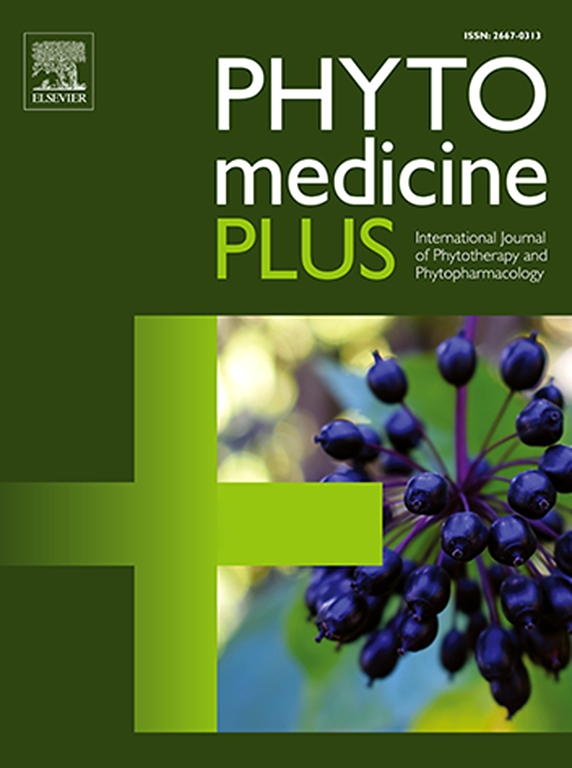Exploring the multifaceted roles of Sonneratia apetala and Nipa fruticans in coastal habitat restoration and bioactive properties discovery
Q3 Pharmacology, Toxicology and Pharmaceutics
引用次数: 0
Abstract
Background
Sonneratia apetala and Nipa fruticans are mangrove species, perennial wild plants with significant therapeutic, ecological, and environmental value. They are extensively utilized by the local communities of the Sundarbans and coastal estuaries for various purposes. Aim of the study: This study aims to provide an in-depth review of these plants, relying on secondary data and information.
Methods
Compile the secondary data from at least 50 relevant pieces of literature.
Results
S. apetala fruits exhibit substantial antioxidant, antimicrobial, analgesic, antidiarrheal, and anti-diabetic properties. Additionally, the bark and leaves offer considerable therapeutic benefits. The plant contains various phytochemicals such as polyphenols include flavonoids, anthocyanins and alkaloids along with carbohydrates, proteins, fiber, minerals (such as Ca, K, Mg, S, Cu, Fe, Zn, Mn), and vitamins (including thiamine and riboflavin). Its leaf and fruit extracts show potential for applications in the food industry and green chemistry. The seed extract demonstrates the highest cytotoxic properties (LC50=36 μg/mL) among other parts of the plant, along with antibacterial effects and dose-dependent analgesic and antidiarrheal properties. The leaf and bark extracts exhibit significant antidiabetic potential, with IC50 values of 0.286±0.022 and 0.432±0.01 mg/mL respectively. The seeds are particularly rich in polyphenols (300.1 mg GAE/g), flavonoids (30.6 mg CE/g), anthocyanins (2.3 μmol/g), and vitamin C (4.0 mg/g), showcasing their strong antioxidant properties. The pericarp, though lower in these compounds, still presents significant nutritional value, containing 55.4 mg GAE/g polyphenols and 14.6 mg CE/g flavonoids. Nutritional analysis shows the pericarp's moisture content is 84.2 %, along with high carbohydrates (29.6 %) and proteins (8.8 %), while the seed has 55.6 % moisture and 11.5 % proteins. Nipa fruticans presents lucrative findings, including vinegar production, low-fat biscuits with high nutrient values, bioethanol, among others. Various parts of this plant contain essential elements in significant amounts and only trace amounts of heavy metals, indicating its safety for medicinal purposes.
Conclusion
The phytochemical, nutritional, and elemental analyses of these plants highlight its potential health benefits, food value and significance in research. This comprehensive analysis underscores S. apetala's and N. fruticans broad nutritional and phytochemical significance, making it a valuable subject in studies of natural products and human health.

探索无瓣海桑和水果树在沿海生境恢复和生物活性特性发现中的多重作用
无瓣海桑和果皮海桑是红树林多年生野生植物,具有重要的治疗、生态和环境价值。它们被孙德尔本斯和沿海河口的当地社区广泛用于各种目的。研究目的:本研究的目的是对这些植物进行深入的综述,依靠二手数据和信息。方法从至少50篇相关文献中收集辅助资料。无瓣草果实具有丰富的抗氧化、抗菌、镇痛、止泻和抗糖尿病特性。此外,树皮和叶子提供相当大的治疗效益。这种植物含有多种植物化学物质,如多酚类化合物,包括类黄酮、花青素和生物碱,以及碳水化合物、蛋白质、纤维、矿物质(如钙、钾、镁、硫、铜、铁、锌、锰)和维生素(包括硫胺素和核黄素)。其叶子和果实提取物在食品工业和绿色化学方面具有潜在的应用前景。该种子提取物显示出最高的细胞毒性(LC50=36 μg/mL),同时具有抗菌作用和剂量依赖性镇痛和止泻作用。其叶提取物和树皮提取物的IC50值分别为0.286±0.022和0.432±0.01 mg/mL。尤其富含多酚(300.1 μmol/g)、黄酮类化合物(30.6 mg CE/g)、花青素(2.3 μmol/g)和维生素C (4.0 mg/g),具有较强的抗氧化性能。果皮虽然这些化合物含量较低,但仍具有显著的营养价值,含有55.4 mg GAE/g多酚和14.6 mg CE/g黄酮类化合物。营养分析表明,果皮的水分含量为84.2%,高碳水化合物(29.6%)和蛋白质(8.8%),而种子的水分含量为55.6%,蛋白质含量为11.5%。Nipa fruticans提出了有利可图的发现,包括醋生产、高营养价值的低脂饼干、生物乙醇等。这种植物的各个部分含有大量的必需元素,只有微量的重金属,表明其药用安全性。结论这些植物的化学、营养和元素分析突出了其潜在的保健价值、食品价值和研究意义。这一综合分析强调了无花瓣草和水果草广泛的营养和植物化学意义,使其成为研究天然产物和人类健康的一个有价值的主题。
本文章由计算机程序翻译,如有差异,请以英文原文为准。
求助全文
约1分钟内获得全文
求助全文
来源期刊

Phytomedicine Plus
Medicine-Complementary and Alternative Medicine
CiteScore
3.70
自引率
0.00%
发文量
178
审稿时长
81 days
期刊介绍:
 求助内容:
求助内容: 应助结果提醒方式:
应助结果提醒方式:


